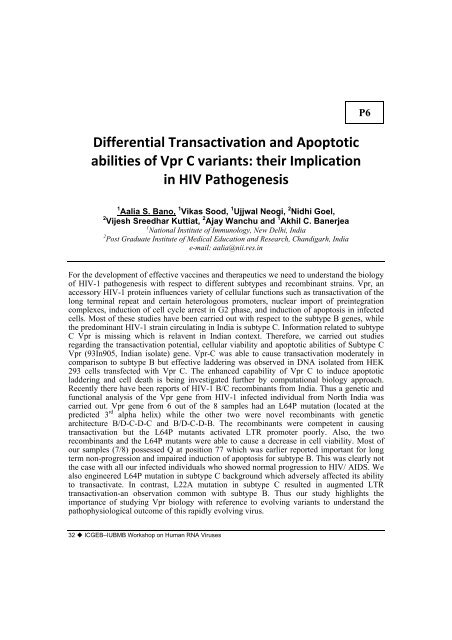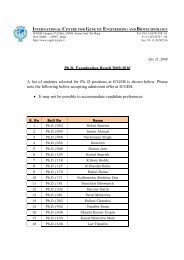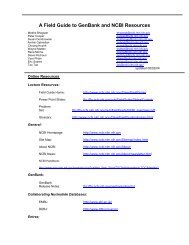You also want an ePaper? Increase the reach of your titles
YUMPU automatically turns print PDFs into web optimized ePapers that Google loves.
Differential Transactivation and Apoptotic<br />
abilities of Vpr C variants: their Implication<br />
in HIV Pathogenesis<br />
1 Aalia S. Bano, 1 Vikas Sood, 1 Ujjwal Neogi, 2 Nidhi Goel,<br />
2 Vijesh Sreedhar Kuttiat, 2 Ajay Wanchu and 1 Akhil C. Banerjea<br />
1 National Institute of Immunology, New Delhi, India<br />
2 Post Graduate Institute of Medical Education and Research, Chandigarh, India<br />
e-mail: aalia@nii.res.in<br />
For the development of effective vaccines and therapeutics we need to understand the biology<br />
of HIV-1 pathogenesis with respect to different subtypes and recombinant strains. Vpr, an<br />
accessory HIV-1 protein influences variety of cellular functions such as transactivation of the<br />
long terminal repeat and certain heterologous promoters, nuclear import of preintegration<br />
complexes, induction of cell cycle arrest in G2 phase, and induction of apoptosis in infected<br />
cells. Most of these studies have been carried out with respect to the subtype B genes, while<br />
the predominant HIV-1 strain circulating in India is subtype C. Information related to subtype<br />
C Vpr is missing which is relavent in Indian context. Therefore, we carried out studies<br />
regarding the transactivation potential, cellular viability and apoptotic abilities of Subtype C<br />
Vpr (93In905, Indian isolate) gene. Vpr-C was able to cause transactivation moderately in<br />
comparison to subtype B but effective laddering was observed in DNA isolated from HEK<br />
293 cells transfected with Vpr C. The enhanced capability of Vpr C to induce apoptotic<br />
laddering and cell death is being investigated further by computational biology approach.<br />
Recently there have been reports of HIV-1 B/C recombinants from India. Thus a genetic and<br />
functional analysis of the Vpr gene from HIV-1 infected individual from North India was<br />
carried out. Vpr gene from 6 out of the 8 samples had an L64P mutation (located at the<br />
predicted 3 rd alpha helix) while the other two were novel recombinants with genetic<br />
architecture B/D-C-D-C and B/D-C-D-B. The recombinants were competent in causing<br />
transactivation but the L64P mutants activated LTR promoter poorly. Also, the two<br />
recombinants and the L64P mutants were able to cause a decrease in cell viability. Most of<br />
our samples (7/8) possessed Q at position 77 which was earlier reported important for long<br />
term non-progression and impaired induction of apoptosis for subtype B. This was clearly not<br />
the case with all our infected individuals who showed normal progression to HIV/ AIDS. We<br />
also engineered L64P mutation in subtype C background which adversely affected its ability<br />
to transactivate. In contrast, L22A mutation in subtype C resulted in augmented LTR<br />
transactivation-an observation common with subtype B. Thus our study highlights the<br />
importance of studying Vpr biology with reference to evolving variants to understand the<br />
pathophysiological outcome of this rapidly evolving virus.<br />
32 � <strong>ICGEB</strong>–IUBMB Workshop on <strong>Human</strong> <strong>RNA</strong> <strong>Viruses</strong><br />
P6





